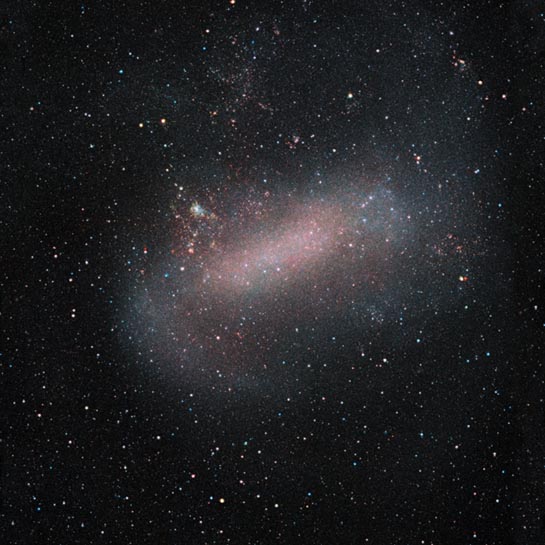
Irregular galaxy
RA 5h 25m 10.58s Dec -70° 4' 22.75"
Mensa
163,000 light-years
0.9
10.75° × 9.17°
461.90 x 515.88 arcminutes
North is 2.4° right of vertical
ESO/VMC Survey
September 13, 2019
ABOUT
THIS IMAGE:
The Large Magellanic Cloud, or LMC, is one of our nearest galactic neighbors, at only 163,000 light years from Earth. With its sibling the Small Magellanic Cloud, these are among the nearest dwarf satellite galaxies to the Milky Way. The LMC is also the home of various stellar conglomerates and is an ideal laboratory for astronomers to study the processes that shape galaxies.
ESO's VISTA telescope, has been observing these two galaxies for the last decade. The image presented today is the result of one of the many surveys that astronomers have performed with this telescope. The main goal of the VISTA Magellanic Clouds (VMC) Survey has been to map the star formation history of the Large and Small Magellanic Clouds, as well as their three-dimensional structures.
VISTA was key to this image because it observes the sky in near-infrared wavelengths of light. This allows it to see through clouds of dust that obscure parts of the galaxy. These clouds block a large portion of visible light but are transparent at the longer wavelengths VISTA was built to observe. As a result, many more of the individual stars populating the center of the galaxy are clearly visible. Astronomers analyzed about 10 million individual stars in the Large Magellanic Cloud in detail and determined their ages using cutting-edge stellar models[1]. They found that younger stars trace multiple spiral arms in this galaxy.
For millennia, the Magellanic Clouds have fascinated people in the Southern Hemisphere, but they were largely unknown to Europeans until the Age of Discovery. The name we use today harkens back to the explorer Ferdinand Magellan, who 500 years ago began the first circumnavigation of the Earth. The records the expedition brought back to Europe revealed many places and things to Europeans for the first time. The spirit of exploration and discovery is ever more live today in the work of astronomers around the world, including the VMC Survey team whose observations led to this stunning image of the LMC.
Notes:
[1] Stellar models allow astronomers to predict the life and death of stars, providing insights into properties like their ages, mass, and temperature.
From Wikipedia:
The Large Magellanic Cloud (LMC) is a satellite galaxy of the Milky Way. At a distance of about 50 kiloparsecs (˜163,000 light-years), the LMC is the second- or third-closest galaxy to the Milky Way, after the Sagittarius Dwarf Spheroidal (~16 kpc) and the possible dwarf irregular galaxy known as the Canis Major Overdensity. Based on readily visible stars and a mass of approximately 10 billion solar masses, the diameter of the LMC is about 14,000 light-years (4.3 kpc), making it roughly one one-hundredth as massive as the Milky Way. This makes the LMC the fourth-largest galaxy in the Local Group, after the Andromeda Galaxy (M31), the Milky Way, and the Triangulum Galaxy (M33).
The LMC is classified as a Magellanic spiral. It contains a stellar bar that is geometrically off-center, suggesting that it was a barred dwarf spiral galaxy before its spiral arms were disrupted, likely by tidal interactions from the Small Magellanic Cloud (SMC), and the Milky Way's gravity.
With a declination of about -70°, the LMC is visible as a faint "cloud" only in the southern celestial hemisphere and from latitudes south of 20° N, straddling the border between the constellations of Dorado and Mensa, and appears longer than 20 times the Moon's diameter (about 10° across) from dark sites away from light pollution.
The
Milky Way and the LMC are expected to collide in approximately 2.4 billion
years.